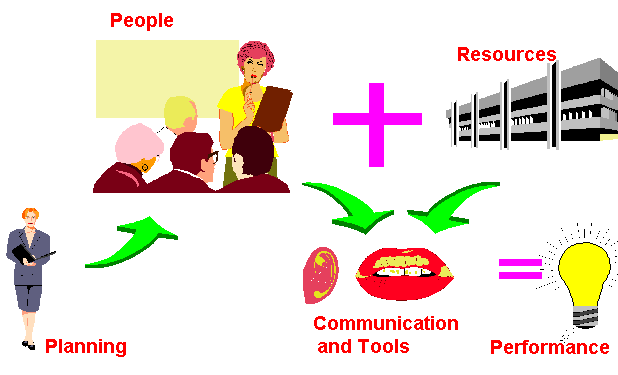Conducting Meetings

One of the biggest complaints about many organizations are meetings . . . they waste too much of our precious time. This is bad news for the leadership team as meetings are important because that is where an organization's culture and climate perpetuates itself.
Meetings are one of the ways that the organization's leaders tell its workers, “You are a member.” If you have bad, boring, and time wasting meetings, then the people begin to believe that this is a bad and boring company that does not care about time. Likewise, great meetings tell the workers, “This is a GREAT organization to be working for!” In addition, bad meetings lead to more bad meetings, which cost even more money.

Planning a meeting involves people, communication, and tools
Why are there so many bad meetings? Because of poor planning by the meeting's organizer and a lack of involvement by the participants. Listed below are recommended guidelines for conducting effective meetings:
Prepare For the Meeting
-
Define the objectives and desired outcomes. Know what you are trying to achieve by having a meeting.
-
Determine if a different activity or medium could be used besides a meeting. A lot of wasted meetings are called when a couple of phone calls, email, or one-on-ones would have worked better.
-
Determine topics to cover and the best format for the discussion of each one. Know what you want to get accomplished by the end of the meeting.
-
Estimate the length of the meeting. People need to know how much time they need to allocate for the meeting.
-
Create an agenda that is carefully scripted:
-
Give Start and Stop times. Time is money — plan wisely!
-
Identify the place of the meeting.
-
List participants and guests.
-
List what the participants' roles are and what is expected from them so they may gather all the relevant data they need to bring to the meeting.
-
Prepare a structured discussion to frame the purpose, topics, and direction of the meeting.
-
-
Deliver the agenda in advance so that the participants have time to plan and prepare for the meeting.
-
Make every meeting a learning event: incorporate creative and cutting edge education on your particular topic by using books, speakers, or videos. The people attending are giving up their time for you, thus you need to give something back to them.
-
Use a variety of tools and activities to make the meeting productive and fun — get them charged up!

Prepare to Attend a Meeting (for all participants)
-
Know the purpose of the meeting. Know what your purpose for attending is.
-
Gather all data that you need to bring to the meeting.
-
Know the agenda of the meeting and ensure your agenda coincides with the meeting agenda.
-
Know your role and the path that you are going to follow.
-
Arrive on time and be prepared to stay until at least the planned stop time.
-
Take the meeting seriously, but do have some fun while attending.
Set Up The Meeting Place
-
Select a physical setting that is comfortable, big enough, and will serve the purpose.
-
Create a warm and attractive atmosphere conducive to interaction.
-
Provide appropriate refreshments.
-
Have appropriate visual aids and learning aids on hand.
-
Always do something a little different and something new. Make them glad that they came.
Assign a Note Taker to Record (minutes):
-
Who attended
-
What problems were discussed
-
Key decisions reached
-
Next Steps (action items):
-
Who needs to accomplish a task — list team and outside members?
-
Start and end date of task.
-
What is it exactly that they need to accomplish?
-
Start the Meeting
-
Communicate the purpose and desired outcomes to all participants.
-
Clarify the type of participation and interaction desired.
-
Set the ground rules (Norms):
-
When the meeting will stop and end.
-
How each member will be heard.
-
How conflict will be resolved.
-
What is expected of each member.
-
Confidential topics.
-
-
Show that you value their ideas, opinions, and questions.
Conduct the Meeting
-
Take time to tell and hear stories (this is how people learn). Be creative in how you share them.
-
Clarify and paraphrase key ideas.
-
Ask for different points of view; protect new ideas.
-
Use brainstorming techniques.
-
Record ideas and notes on a flip chart:
-
Use bright colors and bold shapes.

-
Use pictures, as well as text.
-
Use bullets to emphasize key points, but use no more than 7 words per line and 7 lines per chart.
-
Keep all flip charts posted so that they can easily be referred back to.
-
At the end of the meeting, give them to the note taker so that they can be incorporated into the minutes.
-
-
Ask open-ended questions to encourage their input.
-
Keep the focus on ideas and objectives, not people.
-
Assign next steps throughout the meeting. Make all next steps specific assignments.
-
Stay focused on the agenda topics. Do not wander off topic or become distracted. Agendas are worth taking seriously as long as they do not become personal nor stifle creativity or insult participants who stray.
Keep The Meeting Focused And Moving
-
Get information and data from the meeting. Ensure people are heard.
-
Let the people carry the content; you guide the process.
-
Acknowledge and reinforce constructive contributions.
-
Use the agenda to stay on track.
-
Vary the pace: speed up, slow down, take breaks, change tracks.
-
Keep the group aware of where they are in the process.
-
Periodically summarize key points and ask for agreement.
-
Help the group reach consensus and reach conclusions.
Closing the Meeting
-
Help the group decide on next steps.
-
Review assigned next steps. Ensure each person knows their duties to perform. Ensure everyone goes from “meeting” to “doing.”
-
Conclude by summarizing the group's accomplishments.
-
Thank group members sincerely for their participation and contributions.
Follow Up (Next Steps or Action Items)
-
Evaluate the meeting. What worked? What needs improvement?
-
Plan post-meeting logistics.
-
Using the minutes and your impressions, create a document that clearly describes the meeting. Use comments, questions, criticisms, and insights to enhance the quality of the document.
-
Distribute the document to all participants and other key players within the organization.
-
Monitor progress on next steps.
Next Steps
Activity: Activities for Learning to Create Successful Meetings
Next chapter: Communication
Also, see Presentations
Return to the Main Leadership Menu
